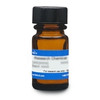Abamectin, a natural product, is a macrocyclic lactone belonging to the Avermectin family. It is broad-spectrum insecticide (miticide and nematicide) and antiparasitic agent. It is used for agricultural and veterinary research. Abamectin is composed of avermectin B1a and avermectin B1b. These two components have similar biological properties.
This product is considered a dangerous good. Quantities above 1 g may be subject to additional shipping fees. Please contact us for questions.
| Mechanism of Action | Abamectin stimulates the release of gamma-aminobutyric acid (GABA) an inhibitory neurotransmitter. It inhbits FOF1-ATPase and the adenine nucleotide translocator (ANT), preventing mitochondrial respiration. |
| Spectrum | Effective against insects, nematodes, mites. Seed treatment for nematode control. |
| Eukaryotic Cell Culture Applications | Abamectin was found to be toxic to isolated male rat hepatocytes, and 10-100 uM for 2 hrs decreased the cell viability in a time and dose-dependent manner (El-Shenawy et al, 2010). |
| Insect Biology Applications | Abamectin resistance in the two-spotted spider mite is associated with cys-loop ligand-gated ion channels (CysLGIC) There are known and novel mutations in glutamate- and histamine-gated chloride channel genes. The study provides toxicological insights to explore the cysL GIC subunits as molecular targets for chemical control strategies (Dermauw et al, 2012). |
| References | Dermauw W et al (2012) The cys-loop ligand-gated ion channel gene family of Tetranychus urticae: Implications for acaricide toxicology and a novel mutation associated with abamectin resistance. Insect Biochem Mol Biol. 2012 42(7):455-465 PMID 22465149 El-Shenawy NS et al (2010) Effects of insecticides fenitrothion, endosulfan and abamectin on antioxidant parameters of isolated rat hepatocytes.Toxicol In Vitro.24(4):1148-1157 PMID 20214973 |


